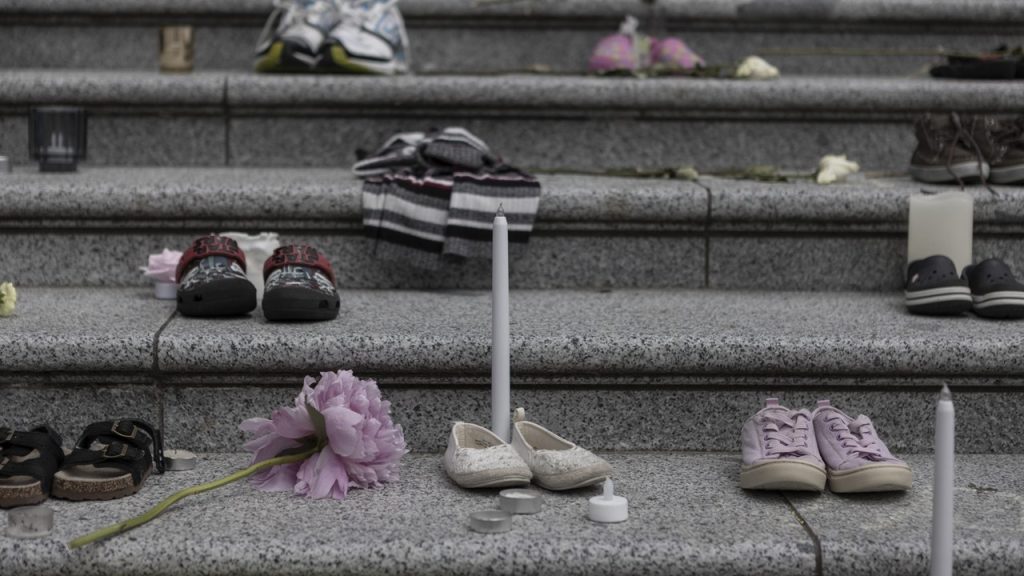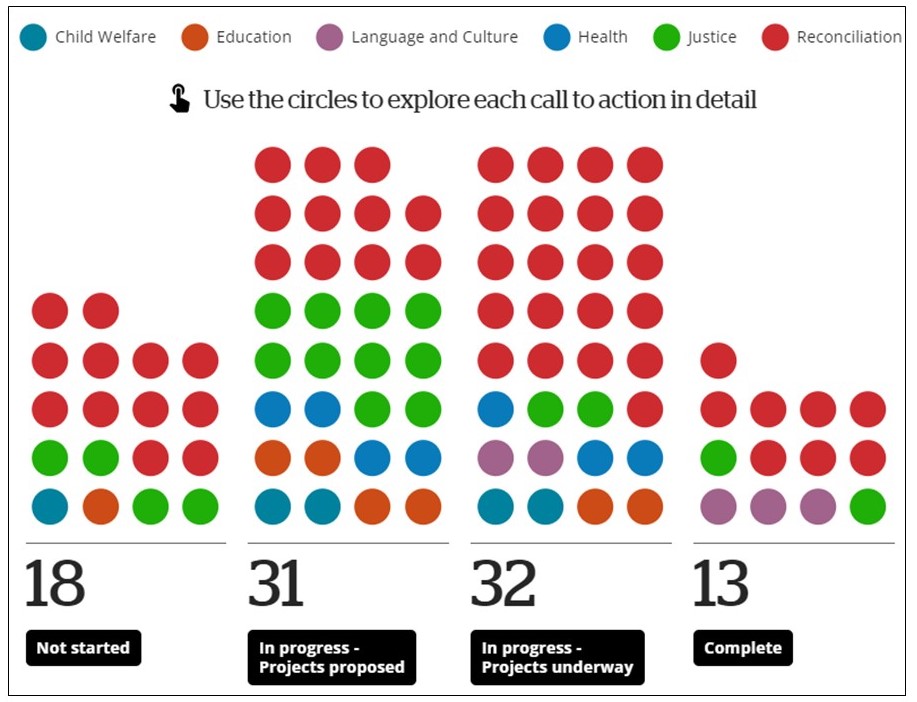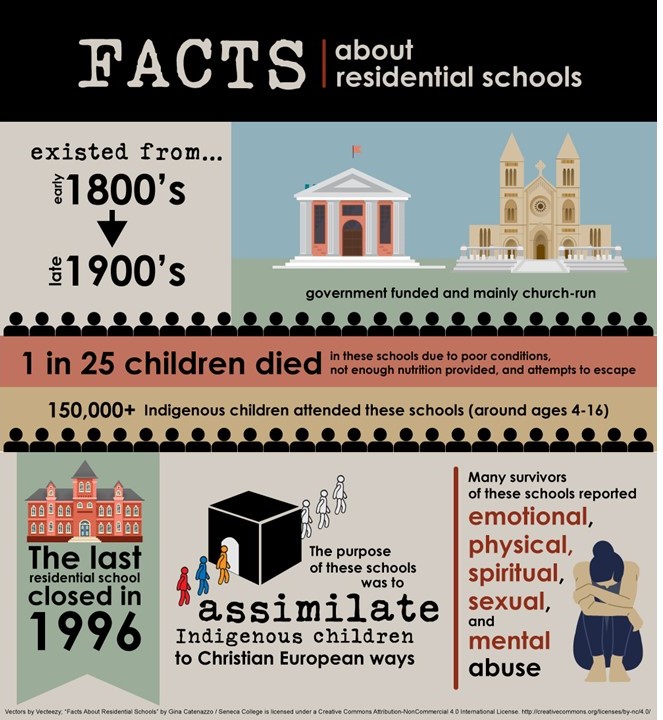A2: Towards Truth and Reconciliation
Canada’s first National Day for Truth and Reconciliation occurred on September 30, 2021. This day was meant to mark “the experiences of First Nation, Inuit and Métis Peoples who went through residential school system, a chain of institutions disguised as schools to assimilate Indigenous children into mainstream Canadian society” (APTN National News, 2021) and to recognize the generational impacts of this system on Indigenous peoples. Recognizing this day came about in fulfillment of Call 80 of the Truth and Reconciliation Commission Calls to Action. Honourable Justice Murray Sinclair, Chair of the Truth and Reconciliation Commission of Canada, says in the interview that the National Day for Truth and Reconciliation is about atoning for what was done and ensuring it never happens again and that the first step in reconciliation is to learn the truth about Canada.
As stated in the previous chapter, the truth is, the nation of Canada was founded on patriarchal, monarchist, Christian, white European colonialism. While we know that stating this so boldly is no doubt going to offend some people, we must open ourselves up to the truth about Canada’s history. In doing so, we can also recognize that although this fact is Canada’s historical foundation, it no longer needs to be our present and our future. The future is created by us. We have the power to take this history and its ongoing impact and create a more equitable and just future by walking down the road to reconciliation.
Although the term reconciliation may be familiar. Full awareness as to what reconciliation really means for all of us is sometimes lacking. The Honourable Justice Murray Sinclair provides a brief overview of what reconciliation means in the following video.
Residential Schools – A Summary
Content Warning: Please note that this section covers difficult topics and Survivor stories related to residential schools that some readers may find distressing. For residential school Survivors and their families, 24-hour support is available through the Indian Residential Schools Crisis Line at 1-800-721-0066. If you’re a student from an Ontario college, please consult the student support services available at your college.
From 1883 to 1996, Christian churches ran more than 130 federally-funded residential schools which were created to assimilate Indigenous children into Canadian society. Over 150,000 First Nations, Inuit, and Métis children and youth were forcibly taken from their homes and placed in residential schools. Many children died as a result of inadequate conditions and abuse. Those who survived, experienced trauma and its continued effects. The 2015 Truth and Reconciliation Commission report called the residential school system and act of cultural genocide by the Canadian government and Christian churches (Defining Moments in Canada, n.d.).
The history of residential schools in Canada can be traced as far back as the 17th century. Watch the video below, Residential Schools in Canada: A Timeline, to learn about the significant dates in its history.
Some additional facts about residential schools are illustrated in Figure B1.1.
For more information, please visit the Residential Schools Timeline on the Canadian Encyclopaedia website.

The Truth and Reconciliation Commission made it clear that there are numerous children who were taken from their families to attend residential schools who were never heard from again, and that it is highly likely that many of these children are in unmarked graves on properties near former residential schools. Currently, many First Nations are in the painful process of uncovering the locations of some of these grave sites. The first of these discovers was at the former Kamloops Indian Residential School on the traditional territory of the Tk’emlúps te Secwépemc people.
Intergenerational Trauma
Intergenerational or historical trauma, is trauma experienced by cultural groups as a result of oppression. When nothing is done to address the trauma, it gets passed down through generations. At the same time, harmful behaviours that arose because of the trauma eventually become normalized and continue to become present through generations (Teach for Canada). In the case of residential schools, children who were in these schools “returned to their home communities without the knowledge, skills or tools to cope in either world. The impacts of their institutionalization in residential school continue to be felt by subsequent generations” (The Canadian Encyclopedia).
Intergenerational effects of resident schools include:
- Family & parenting: Because residential schools enforced a parenting model that is based on abuse, punishment, control, and neglect, Survivors of residential schools weren’t familiar with how to create nurturing environments for their own children. This has also been attributed to higher rates of family violence and domestic partner abuse among Survivors.
- Mental health: The psychological, spiritual, physical and sexual abuses experienced by residential school Survivors have resulted in mental health challenges for many.
- High rates of unemployment and homelessness.
- Poor housing conditions in First Nations communities.
- Higher number of Indigenous Peoples involved in the justice system. (The Canadian Encyclopedia)
Towards Reconciliation
Reconciliation Starts with Survivors
It can be difficult to hear the stories directly from Survivors about their residential school experiences. It is important though to acknowledge their courage in coming forth in their class action lawsuit to speak the truth and ask for accountability from the Government. If not for their voice, we would not be in this moment of opportunity to know the truth about the past and to work towards a more equitable and just future for Indigenous people on Turtle Island.
Watch the animated short documentary, Namwayut: We Are All One, where Chief Robert Joseph shares some of his residential school experiences.
As you view the video, consider the hope Chief Robert Joseph holds that because we are all one, reconciliation is possible.
94 Calls To Action
Learning about and acknowledging the truth is one of the steps towards genuine reconciliation. As the Truth and Reconciliation Commission stated in their final report, “Without truth, justice, and healing, there can be no genuine reconciliation. Reconciliation is not about ‘closing a sad chapter of Canada’s past,’ but about opening new healing pathways of reconciliation that are forged in truth and justice.”
Focusing on Canada’s residential school history and legacy is challenging. Hope is gifted to us though through the Calls to Action. The 94 Calls make it very clear as to what needs to change in Canadian society in order to learn from the past, to address the inequities that exist, and reconcile relationships. It will take personal, public, and political will to see these Calls to Action met. We all must do our part.

Read the Truth and Reconciliation Commission of Canada: Calls to Action and consider:
- Which of the calls to action are relevant to you in your future career and field ?
- What actions are you taking, or do you need to take, to meet these Calls?
The CBC has created this interactive news page, Beyond 94, that tracks the progress of the Calls to Action. Visit Beyond 94 and explore the interactive features.
After reviewing Beyond 94, in your opinion, how is Canada doing in meeting the Calls to Action?
The six volumes of the Truth and Reconciliation Commission of Canada report are available through McGill-Queen’s University Press or can be read online at this Government of Canada website.
If you are unable to read the report in its entirety, please read The Summary of the Final Report of the Truth and Reconciliation Commission of Canada, Honouring the Truth, Reconciling for the Future.
An even more abridged version of the report is available as A Knock on the Door, that can be heard as an audiobook.
Conclusion
Jody Wilson-Raybould (2022) says this about what the process to true reconciliation will involve:
True reconciliation is a marathon, not a sprint. True reconciliation is not an event. There is not a moment of time when it happens, and after which we can say ‘we are done’ and move onto something else. It is ongoing, a long-term undertaking of creating new patterns of social, cultural, and economic relations as individuals, peoples, communities, and governments. It is about building a vision of the future that both addresses, and breaks away from, the legacy of colonialism. Achieving this takes endurance, resilience, and consistent effort. It also means recognizing from the beginning that it requires staying the course, even when it feels incredibly hard.
Attributions
This page has been edited and remixed from the following sources. Supplemental information has been provided by Tricia Hylton.
College Libraries Ontario. (n.d.). Maamwi. The Learning Portal. https://tlp-lpa.ca/maamwi
“Skoden” Copyright © 2022 by Seneca College is licensed under a Creative Commons Attribution-NonCommercial-ShareAlike 4.0 International License, except where otherwise noted.
References
APTN National News. (2021). It’s like renewing our vow’: Murray Sinclair says it will take a while to figure out Sept. 30 but we shouldn’t give up. Featured. https://www.aptnnews.ca/featured/its-like-renewing-our-vow-murray-sinclair-says-it-will-take-a-while-to-figure-out-sept-30-but-we-shouldnt-give-up/
Burns, A. (2017). Murray Sinclair what is reconciliation? TRC [Video]. Youtube. https://www.youtube.com/watch?v=swo9flbACho.
CBC. (2018). Namwayut: We are all one. Truth and reconciliation in Canada [Video]. Youtube. https://www.youtube.com/watch?v=2zuRQmwaREY
CBCNews. (2018). Beyond 94: Truth and reconciliation in Canada. https://www.cbc.ca/newsinteractives/beyond-94?&cta=26
Historica Canada. (2020). Residential schools in Canada: A timeline [Video]. Youtube. https://www.youtube.com/watch?v=VFgNI1lfe0A.
Wilson-Raybould, J. (2022). True reconciliation. How to be a force for change. Penguin Random House Canada. https://www.penguinrandomhouse.ca/books/718227/true-reconciliation-by-jody-wilson-raybould/9780771004384


